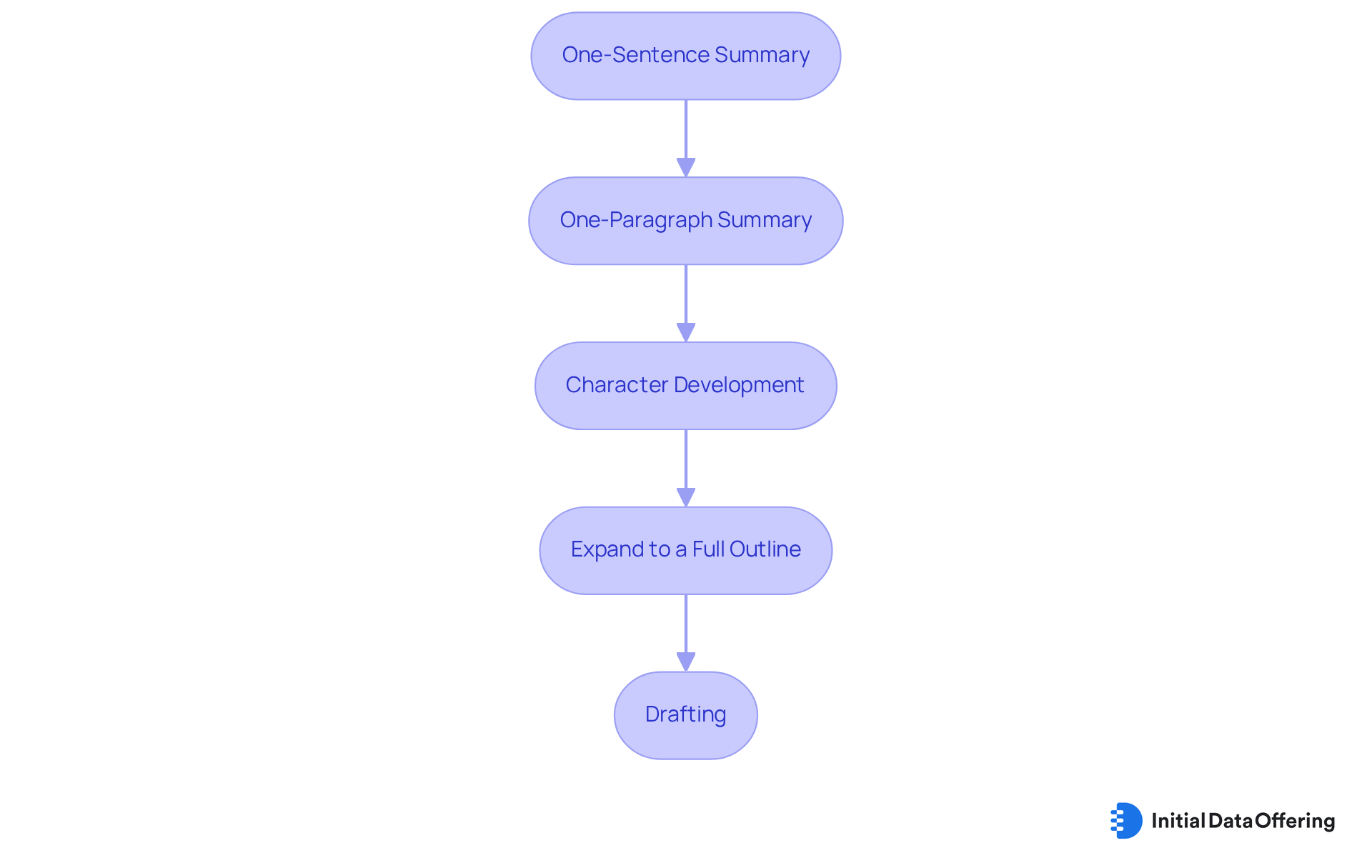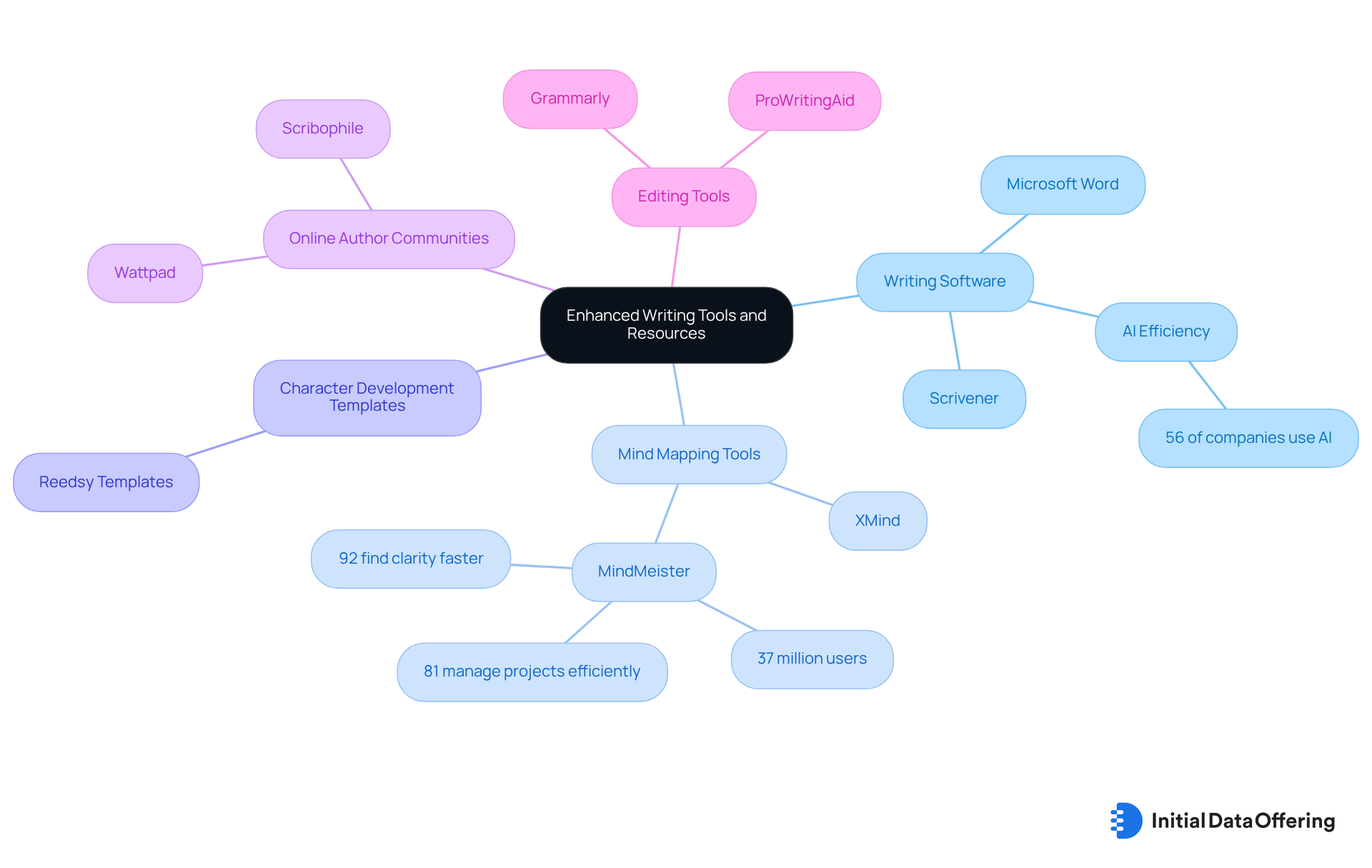Create Stage Snowflake: Step-by-Step Process for Writers

Create Stage Snowflake: Step-by-Step Process for Writers
Overview
The article outlines a step-by-step process for writers to create a 'Stage Snowflake,' a structured method for developing a narrative from a simple idea to a comprehensive outline. This process features detailed steps such as:
- Crafting summaries
- Creating character profiles
- Developing scene outlines
The advantages of this approach include enhanced storytelling clarity and depth. Ultimately, these benefits foster creativity in the writing process, encouraging writers to explore their narratives more fully. How might this structured approach transform your writing experience?
Introduction
The art of storytelling hinges on a writer's ability to transform a mere idea into a captivating narrative. The Snowflake Method, developed by Randy Ingermanson, offers a systematic approach that guides authors through a structured process. This method enables writers to develop their stories with clarity and depth, addressing a common challenge: the initial steps of crafting a compelling narrative.
How can writers effectively utilize this method to create a strong foundation for their stories? This guide explores the step-by-step process of creating a stage snowflake, providing valuable insights and practical tools to enhance storytelling skills and engage readers more effectively.
Understand the Snowflake Method Basics
The Ingermanson Method offers a structured approach to writing that empowers writers to craft their narratives with both clarity and depth. This method is especially advantageous for novelists, guiding them from a simple idea to a comprehensive outline through ten well-defined steps. The key components of the Snowflake Method include:
- One-Sentence Summary: Start with a succinct sentence that captures the essence of your narrative, providing a clear focus.
- One-Paragraph Summary: Expand your initial sentence into a paragraph that outlines the major events of the narrative.
- Character Development: Develop detailed profiles for your main characters, including their motivations, goals, and conflicts to enrich the narrative.
- Expand to a Full Outline: Transform your one-paragraph summary into a detailed outline that specifies each scene and its significance.
- Drafting: Utilize your outline as a roadmap to compose the initial version of your narrative.
By mastering these foundational elements, writers can effectively navigate the subsequent stages of the method, which will help them to create stage snowflake, enhancing their storytelling capabilities and fostering creativity in their writing process. As Ingermanson notes, this method serves as an alternative teaching aid, using a narrative to illustrate how to compose a novel rather than simply instructing. Additionally, authors can utilize Plottr, a software application designed to assist with the method, making the process quicker and more enjoyable. Engaging in these steps not only aids in organization but also ignites creativity, allowing novelists to bring their unique narratives to life.

Follow the Step-by-Step Process to Create Your Stage Snowflake
To create your Stage Snowflake, follow these detailed steps:
-
Create Your One-Sentence Summary: Start by composing a succinct sentence that captures the core of your narrative. For instance, 'A young woman discovers her family's hidden past while searching for her identity.' This summary will act as your guiding star throughout the writing process. Notably, people are 22 times more likely to remember a story-based fact compared to standalone facts, underscoring the importance of a strong narrative foundation.
-
Develop Your One-Paragraph Summary: Expand your one-sentence summary into a paragraph that outlines the main conflict and resolution. Clearly identify the protagonist, their goal, and the obstacles they encounter, providing a snapshot of the narrative arc. This summary serves as a framework for deeper exploration of your story.
-
Profile Descriptions: Create a profile sheet for each primary figure, detailing their name, age, background, motivations, and personal development throughout the narrative. Grasping these elements is essential, as the evolution of personas greatly influences audience involvement. Research indicates that captivating figures can improve storytelling impact by as much as 30%, making this step crucial for engaging your audience.
-
Scene List: Based on your one-paragraph summary, compile a list of key scenes that will propel your story forward. Each scene should serve a distinct purpose, contributing to the development of individuals or advancing the plot. This ensures that your narrative remains focused and impactful.
-
Outline Each Scene: For every scene, write a brief description of the events, the characters involved, and the scene's purpose. This structured approach helps visualize the narrative flow and ensures that each scene aligns with your overall story goals, creating a cohesive reading experience.
-
Draft Your Story: With your outline as a roadmap, begin writing your first draft. Focus on translating your ideas onto the page without striving for perfection; the goal is to capture your narrative. Strong personal arcs within narratives can lead to a 20% increase in audience loyalty, highlighting the importance of character-driven storytelling.
-
Revise and Edit: After completing your draft, dedicate time to revising. Look for inconsistencies in personality development, plot holes, and pacing issues. Effective editing is essential for refining your story, as narratives that incorporate strong character arcs can lead to a 20% increase in audience loyalty.
By following these steps, you will create a stage snowflake that serves as a strong basis for your comprehensive project framework. Ultimately, this structured approach will enhance your storytelling abilities and engage your audience more effectively.

Utilize Tools and Resources for Enhanced Writing
To enhance your writing experience while employing the Snowflake Method, consider utilizing the following tools and resources:
-
Writing Software: Programs like Scrivener or Microsoft Word allow you to organize notes, outlines, and drafts in one centralized location. This organization facilitates a smoother writing process. In fact, 56% of companies are using AI to improve efficiency and productivity, making such software increasingly relevant.
-
Mind Mapping Tools: Tools such as MindMeister or XMind help you visually map out your story structure and the relationships between individuals. Mind mapping has been shown to improve creativity and productivity. Notably, 81% of respondents believe it aids in managing projects more efficiently. Additionally, 92% of respondents said that mind mapping helps distill information and reach clarity faster, making it a valuable resource for writers.
-
Character Development Templates: Websites like Reedsy provide free templates for character profiles. These templates guide you in fleshing out your characters, ensuring they resonate with your audience.
-
Online Author Communities: Participating in platforms such as Wattpad or Scribophile allows you to share your work, obtain constructive feedback, and connect with other creators. This fosters a collaborative atmosphere that can significantly improve your composition journey.
-
Editing Tools: Consider using Grammarly or ProWritingAid for grammar and style checks during the editing phase. These tools can significantly enhance the quality of your composition, allowing you to concentrate on storytelling rather than getting bogged down by technical details.
By leveraging these tools, you can streamline your writing process, enhance your productivity, and dedicate more time to creativity and storytelling.

Conclusion
By adopting the Snowflake Method, writers can transform their initial ideas into well-structured narratives that resonate with readers. This approach provides a clear framework that guides authors through the complexities of storytelling, ensuring that each element of their narrative is thoughtfully developed and interconnected.
The article outlines a systematic process for creating a stage snowflake, emphasizing the importance of starting with a concise one-sentence summary and progressively expanding it into detailed character profiles and scene outlines. Each step, from drafting to revising, is designed to enhance the writer's creativity and organization, ultimately leading to a more compelling story. Utilizing tools like writing software, mind mapping, and character development templates further supports this journey, making the writing process more efficient and enjoyable.
In conclusion, embracing the Snowflake Method not only bolsters storytelling skills but also empowers writers to engage their audiences more effectively. By following the outlined steps and leveraging available resources, writers can craft narratives that not only capture attention but also leave a lasting impact. This structured approach invites all aspiring authors to explore their creativity and take their storytelling to new heights, ensuring their unique voices are heard in a crowded literary landscape.
Frequently Asked Questions
What is the Snowflake Method?
The Snowflake Method is a structured approach to writing that helps writers develop their narratives with clarity and depth, particularly beneficial for novelists.
What are the key components of the Snowflake Method?
The key components include a one-sentence summary, a one-paragraph summary, character development, expanding to a full outline, and drafting.
How does the Snowflake Method start?
It starts with a one-sentence summary that captures the essence of the narrative, providing a clear focus.
What is involved in character development within the Snowflake Method?
Character development involves creating detailed profiles for the main characters, including their motivations, goals, and conflicts.
How do writers expand their narrative in the Snowflake Method?
Writers expand their narrative by taking their one-paragraph summary and transforming it into a detailed outline that specifies each scene and its significance.
What is the purpose of the drafting stage in the Snowflake Method?
The drafting stage uses the outline as a roadmap to compose the initial version of the narrative.
How does the Snowflake Method enhance creativity in writing?
By following the structured steps, writers can organize their thoughts and ignite creativity, allowing them to bring their unique narratives to life.
Is there any software that can assist with the Snowflake Method?
Yes, authors can utilize Plottr, a software application designed to assist with the Snowflake Method, making the process quicker and more enjoyable.
What is the overall benefit of mastering the Snowflake Method?
Mastering the Snowflake Method helps writers effectively navigate the stages of writing, enhancing their storytelling capabilities and fostering creativity in their writing process.